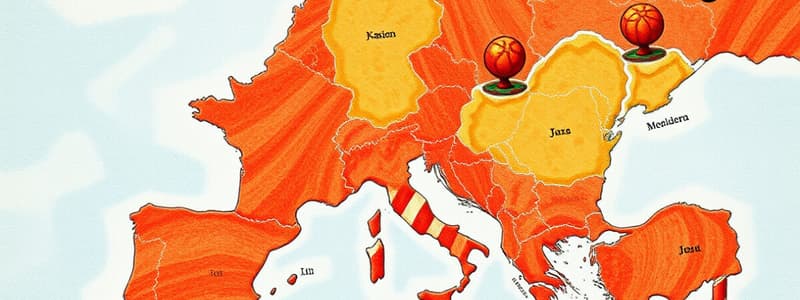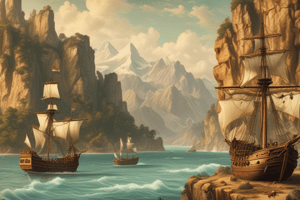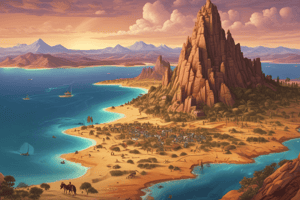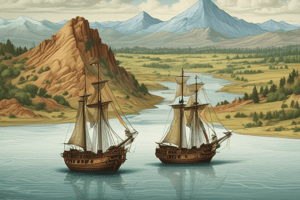Podcast
Questions and Answers
What is a delta?
What is a delta?
- A type of ancient Egyptian ruler
- A piece of land built up by sand and soil at the mouth of a river (correct)
- A large waterfall
- A rock formation in a river
What is a cataract?
What is a cataract?
- A period of food shortage
- An ancient Egyptian writing system
- A device for irrigation
- A large bed of rocks that produces waterfalls (correct)
What is a famine?
What is a famine?
A period of a serious shortage of food
Who was the pharaoh?
Who was the pharaoh?
What is a vizier?
What is a vizier?
What is a shadoof?
What is a shadoof?
What is a mummy?
What is a mummy?
What are pyramids?
What are pyramids?
What is an obelisk?
What is an obelisk?
What is a scribe?
What is a scribe?
What is a palette?
What is a palette?
What is papyrus?
What is papyrus?
What is a scroll?
What is a scroll?
What are hieroglyphics?
What are hieroglyphics?
Who was Menes?
Who was Menes?
Who was Akehenaton?
Who was Akehenaton?
Who was Khufu?
Who was Khufu?
Who was Joseph?
Who was Joseph?
Who was Hatshepsut?
Who was Hatshepsut?
Who was Tutankhamen?
Who was Tutankhamen?
What peninsula has been a land bridge between Africa and Israel?
What peninsula has been a land bridge between Africa and Israel?
What is the world's longest river?
What is the world's longest river?
Because the Nile is so important, Egypt is often called 'the _____ of the Nile.'
Because the Nile is so important, Egypt is often called 'the _____ of the Nile.'
What did the ancient Egyptians call their land because the fertile land ends so abruptly?
What did the ancient Egyptians call their land because the fertile land ends so abruptly?
What is the largest of the pyramids standing today?
What is the largest of the pyramids standing today?
What famous monument has the head of a man and the body of a lion?
What famous monument has the head of a man and the body of a lion?
What do we call the area near Thebes that the pharaohs used as a cemetery?
What do we call the area near Thebes that the pharaohs used as a cemetery?
What was the key to understanding the meaning of hieroglyphics?
What was the key to understanding the meaning of hieroglyphics?
What color did most ancient Egyptians wear and why?
What color did most ancient Egyptians wear and why?
What is the largest desert in the world?
What is the largest desert in the world?
Why is Egypt called the gift of the Nile?
Why is Egypt called the gift of the Nile?
Upon what did Egypt base their season?
Upon what did Egypt base their season?
What did most Egyptians do for work?
What did most Egyptians do for work?
What pet was considered sacred by the Egyptians?
What pet was considered sacred by the Egyptians?
What is a plain?
What is a plain?
What is Africa?
What is Africa?
What is the highest mountain in Africa?
What is the highest mountain in Africa?
What is a mountain?
What is a mountain?
What is a plateau?
What is a plateau?
What is a valley?
What is a valley?
What happened during the flooding season?
What happened during the flooding season?
What happened during the planting season?
What happened during the planting season?
What happened during the harvest season?
What happened during the harvest season?
What two landforms gave special protection to Egypt? How did they provide protection?
What two landforms gave special protection to Egypt? How did they provide protection?
Study Notes
Key Geographical Terms
- Delta: Land formation at a river's mouth from deposits of sand and soil.
- Cataract: Rock formations in rivers that create waterfalls.
- Sahara: The largest desert in the world.
- Plain: A flat or level area of land.
- Plateau: A highland plain.
- Valley: Low land situated between hills or mountains.
Important Historical Figures
- Pharaoh: The title for the ruler of Egypt, also translated as "great house."
- Vizier: The second most powerful official next to the pharaoh.
- Menes: Recognized as the first king of Upper and Lower Egypt.
- Akehenaton: Noted as the first pharaoh in history.
- Khufu: The pharaoh known for constructing the Great Pyramid.
- Hatshepsut: The only female pharaoh of ancient Egypt.
- Tutankhamen: Known as the pharaoh whose tomb is renowned for its riches.
Cultural and Historical Concepts
- Mummy: A preserved body, significant in ancient Egyptian burial practices.
- Pyramids: Tomb structures specifically built for pharaohs.
- Obelisk: Tall, pointed pillars created to honor the sun god.
- Scribe: An individual who served as a secretary to rulers, crucial for record-keeping.
- Hieroglyphics: The Egyptian writing system utilizing picture symbols.
Egyptian Society Resources
- Papyrus: Early form of paper made from a plant, crucial for writing.
- Scroll: A long piece of papyrus or paper rolled up for writing or recording information.
- Shadoof: An ancient irrigation tool consisting of a long pole and bucket.
Ecological and Seasonal Aspects
- Nile River: Recognized as the world's longest river; essential for agriculture and civilization.
- Annual Flooding: The cyclical inundation that enriches soil, marking agricultural seasons in Egypt.
- Farming Seasons:
- Flooding Season: Time for construction while waiting for water to recede.
- Planting Season: When crops are planted in the nutrient-rich soil.
- Harvest Season: Period for gathering crops.
Significance of Egypt's Geography
- "Gift of the Nile": Descriptor highlighting the river's crucial role in sustaining life and agriculture.
- Protection from Invaders: Natural barriers include deserts that dissuade invasion due to harsh conditions and cataracts that hinder river access.
Important Sites and Monuments
- Valley of the Kings: Burial site for pharaohs located near Thebes, a critical archaeological area.
- Great Pyramid: The largest pyramid still standing today, representing ancient engineering prowess.
- Great Sphinx: Iconic monument featuring the body of a lion and a human head, symbolizing strength and wisdom.
- Rosetta Stone: Key artifact for deciphering hieroglyphics, instrumental in understanding ancient Egyptian language.
Lifestyle Aspects
- Egyptian Clothing: Most ancient Egyptians wore white garments, reflecting heat to stay cool.
- Sacred Animals: Cats were considered sacred within Egyptian culture, reflecting their reverence for animals.
Continental Context
- Africa: The second largest continent, housing a diverse range of cultures and geographies, including Egypt within its bounds.
- Kilimanjaro: The highest peak in Africa, representing the continent's geographical diversity.
Studying That Suits You
Use AI to generate personalized quizzes and flashcards to suit your learning preferences.
Description
This quiz features flashcards covering key terms from Chapter 7 of Abeka's Old World History and Geography curriculum. Students will learn important concepts such as delta, cataract, famine, and pharaoh, enhancing their understanding of historical geography.




